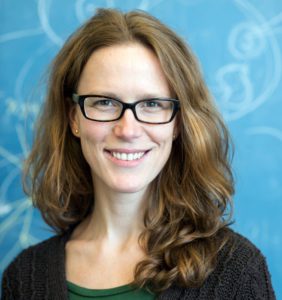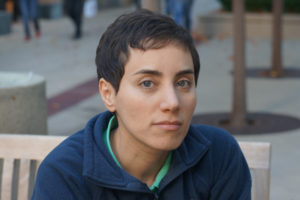Laura DeMarco to Receive 2017 AMS Satter Prize

(News written on 23rd November, 2016)
Providence, RI — Laura DeMarco dari Northwestern University akan menerima 2017 AMS Ruth Lyttle Satter Prize di bidang Matematika. DeMarco dianugerahi “atas kontribusi fundamentalnya pada complex dynamics, potential theory, dan dinamika aritmatika.”
Karya Laura DeMarco berpusat pada sistem dinamis, sebuah cabang matematika yang mempelajari sistem yang berubah dan berkembang, seperti model pola cuaca yang berubah dari waktu ke waktu. Sistem tersebut dapat dibangun dari prosedur yang sangat sederhana, seperti: dimulai dengan suatu bilangan, mengkotaknya dan menambahkan bilangan lain; menggunakan hasil tersebut sebagai titik awal untuk iterasi berikutnya; lanjutkan prosedur tersebut.
Bahkan sistem dinamis sederhana seperti itu dapat menunjukkan pola yang kompleks dan indah; sebagai contoh adalah himpunan Mandelbrot yang telah dikenal dengan baik. Karena sistem-sistem ini didasarkan pada aturan-aturan aritmatika, koneksi-koneksi dengan kemunculan teori bilangan. Koneksi-koneksi ini telah mengarah pada munculnya arithmetic dynamics, yang mana DeMarco telah menjadi salah satu kontributor utama.
DeMarco telah membawa ide-ide baru yang inovatif ke dalam sistem dinamis dengan menggunakan alat dan ide-ide dari bidang lain dalam matematika. Kutipan (atas prize tersebut) mencatat khususnya kerja sama DeMarco dengan M. Baker, yang mengembangkan metode baru melalui sebuah pertemuan ide-ide luar biasa dari dynamical systems theory dan bidang-bidang lain seperti logika, teori bilangan, dan analisis. Pekerjaan lain oleh DeMarco dan K. Pilgrim menyebabkan hasil baru yang mencolok, termasuk generalisasi dari teorema terkenal bahwa himpunan Mandelbrot terhubung. Dalam karya terbarunya, DeMarco menitikkan hubungan antara dynamical systems dan geometri aritmatika dari obyek-obyek yang disebut kurva elips (elliptic curves).
Laura DeMarco meraih gelar sarjana dari University of Virginia dan gelar master dari University of California, Berkeley. Pada tahun 2002, ia menerima gelar PhD dari Harvard University. Di Universitas Chicago, dia adalah National Science Foundation Postdoctoral Fellow, Instruktur Dickson, dan asisten profesor sebelum ia bergabung dengan fakultas di University of Illinois di Chicago. Sementara di sana, ia menerima NSF Karir Award dan Sloan Fellowship. Selama tahun akademik 2013-14, DeMarco adalah Kreeger-Wolf Distinguished Visiting Professor di Departemen Matematika di Northwestern University. Pada tahun 2014 ia diasumsikan posisinya sekarang sebagai guru besar matematika di Northwestern. DeMarco dianugerahi Simons Fellowship pada tahun 2015 dan diberi nama Fellow of the AMS pada tahun 2012.
Dipersembahkan setiap dua tahun, AMS Satter Prize mengakui sebuah kontribusi luar biasa pada penelitian matematika yang dilakukan oleh seorang wanita dalam enam tahun sebelumnya. Penghargaan tersebut akan diberikan pada hari Kamis, 5 Januari, 2017, di Rapat Gabungan Matematika di Atlanta, USA.
Stanford Report, August 12, 2014
Stanford’s Maryam Mirzakhani wins Fields Medal 2014
Maryam Mirzakhani is the first woman to ever win the Fields Medal – known as the “Nobel Prize of mathematics” – in recognition of her contributions to the understanding of the symmetry of curved surfaces.
Maryam Mirzakhani, a professor of mathematics at Stanford, has been awarded the 2014 Fields Medal, the most prestigious honor in mathematics. Mirzakhani is the first woman to win the prize, widely regarded as the “Nobel Prize of mathematics,” since it was established in 1936. The Fields Medal is awarded every four years on the occasion of the International Congress of Mathematicians to recognize outstanding mathematical achievement for existing work and for the promise of future achievement

“This is a great honor. I will be happy if it encourages young female scientists and mathematicians,” Mirzakhani said. “I am sure there will be many more women winning this kind of award in coming years.”
Officially known as the International Medal for Outstanding Discoveries in Mathematics, the Fields Medal will be presented by the International Mathematical Union on Aug. 13 at the International Congress of Mathematicians, held this year in Seoul, South Korea. Mirzakhani is the first Stanford recipient to win this honor since Paul Cohen in 1966.
The award recognizes Mirzakhani’s sophisticated and highly original contributions to the fields of geometry and dynamical systems, particularly in understanding the symmetry of curved surfaces, such as spheres, the surfaces of doughnuts and of hyperbolic objects. Although her work is considered “pure mathematics” and is mostly theoretical, it has implications for physics and quantum field theory.
“On behalf of the entire Stanford community, I congratulate Maryam on this incredible recognition, the highest honor in her discipline, the first ever granted to a woman,” said Stanford President John Hennessy. “We are proud of her achievements, and of the work taking place in our math department and among our faculty. We hope it will serve as an inspiration to many aspiring mathematicians.”
‘Like solving a puzzle’
Mirzakhani was born and raised in Tehran, Iran. As a young girl she dreamed of becoming a writer. By high school, however, her affinity for solving mathematical problems and working on proofs had shifted her sights.
“It is fun – it’s like solving a puzzle or connecting the dots in a detective case,” she said. “I felt that this was something I could do, and I wanted to pursue this path.”
Mirzakhani became known to the international math scene as a teenager, winning gold medals at both the 1994 and 1995 International Math Olympiads – she finished with a perfect score in the latter competition. Mathematicians who would later be her mentors and colleagues followed the mathematical proofs she developed as an undergraduate.
After earning her bachelor’s degree from Sharif University of Technology in 1999, she began work on her doctorate at Harvard University under the guidance of Fields Medal recipient Curtis McMullen. She possesses a remarkable fluency in a diverse range of mathematical techniques and disparate mathematical cultures – including algebra, calculus, complex analysis and hyperbolic geometry. By borrowing principles from several fields, she has brought a new level of understanding to an area of mathematics called low dimensional topology.
Mirzakhani’s earliest work involved solving the decades-old problem of calculating the volumes of moduli spaces of curves on objects known as Riemann surfaces. These are geometric objects whose points each represent a different hyperbolic surface. These objects are mostly theoretical, but real-world examples include amoebae and doughnuts. She solved this by drawing a series of loops across their surfaces and calculating their lengths.
“What’s so special about Maryam, the thing that really separates her, is the originality in how she puts together these disparate pieces,” said Steven Kerckhoff, a mathematics professor at Stanford and one of Mirzakhani’s collaborators. “That was the case starting with her thesis work, which generated several papers in all the top journals. The novelty of her approach made it a real tour de force.”
Pure mathematics
From 2004 to 2008, she was a Clay Mathematics Institute Research Fellow and an assistant professor at Princeton University. In 2008, she became a professor of mathematics at Stanford, where she lives with her husband and 3-year-old daughter.
Mirzakhani’s recent research further investigates the symmetry of surface geometry, particularly within theories regarding Teichmüller dynamics. In general, her work can best be described as pure mathematics – research that investigates entirely abstract concepts of nature that might not have an immediately obvious application.
“Oftentimes, research into these areas does have unexpected applications, but that isn’t what motivates mathematicians like Maryam to pursue it. Rather, the motivation is to understand, as deeply as possible, these basic mathematical structures,” said Ralph Cohen, a professor of mathematics and the senior associate dean for the natural sciences in Stanford’s School of Humanities and Sciences. “Maryam’s work really is an outstanding example of curiosity-driven research.”
The work, however, could have impacts concerning the theoretical physics of how the universe came to exist and, because it could inform quantum field theory, secondary applications to engineering and material science. Within mathematics, it has implications for the study of prime numbers and cryptography. Despite the breadth of applications of her work, Mirzakhani said she enjoys pure mathematics because of the elegance and longevity of the questions she studies.
“I don’t have any particular recipe,” Mirzakhani said of her approach to developing new proofs. “It is the reason why doing research is challenging as well as attractive. It is like being lost in a jungle and trying to use all the knowledge that you can gather to come up with some new tricks, and with some luck you might find a way out.”